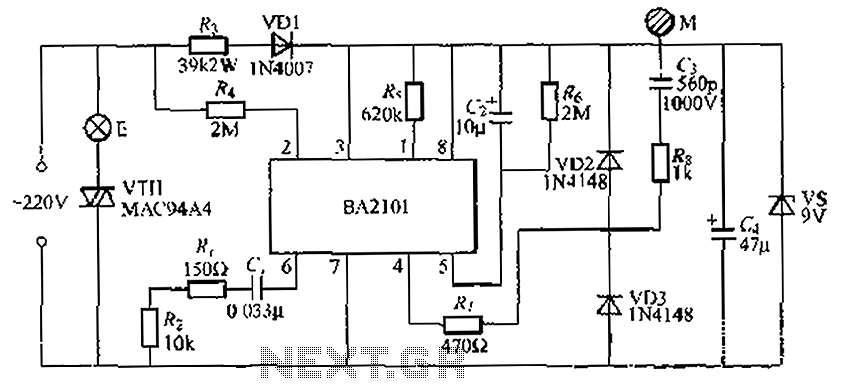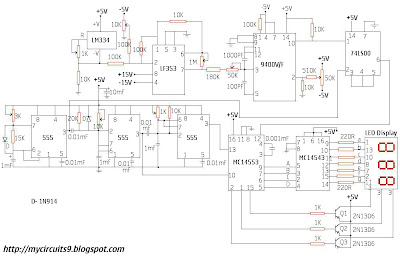
Stairs Corridor light-controlled circuit

The circuit illustrated in Figure 2-50 utilizes a field effect tube and a combination of electronic components to create a unique self-lighting controller. The working lamp remains illuminated at a reduced brightness rather than being completely turned off, which can be beneficial in certain situations. This method also significantly prolongs the lifespan of the lamps, as the filament initially operates at a cooler state with higher resistance, thereby preventing a surge of current when the lamp is connected to the power grid. The delay time for the circuit is determined by the capacitor (Ci) and resistor (Ri), which is approximately 6 minutes as indicated in Figure 2-50. To disconnect the controller and enhance the lighting, for instance, during stair cleaning, the switch (SA) can be toggled to the closed position, allowing the lamp to receive full grid voltage.
The circuit design employs a field effect transistor (FET) as the primary switching element, which is known for its high input impedance and low power consumption. The self-lighting controller operates by gradually increasing the voltage across the lamp, thereby reducing the inrush current that typically occurs when a lamp is turned on. This gradual increase in brightness not only enhances user comfort but also minimizes thermal stress on the filament, leading to a longer operational life for incandescent bulbs.
The delay mechanism is essential for applications where a constant low-level illumination is desired, such as in hallways or staircases. The time constant, governed by the values of the capacitor (Ci) and resistor (Ri), can be adjusted to suit specific requirements. By selecting different component values, the delay time can be modified, allowing for customization based on the intended use of the lighting system.
In practical applications, the circuit can be integrated into various lighting fixtures, providing automatic dimming capabilities. The switch (SA) serves as a manual override, enabling users to bypass the dimming function and access full brightness when necessary. This feature is particularly useful during cleaning or maintenance tasks, ensuring safety and visibility.
Overall, this self-lighting controller circuit represents an innovative approach to lighting management, combining efficiency with user-friendly operation. Its design principles can be adapted for a wide range of lighting applications, making it a versatile solution in modern electrical engineering. Circuit shown in Figure 2-50. This circuit uses field effect tube should, through the ingenious electronic components constitute a unique self-lighting controller. The informal working lamp illumination is not put out off, but the light is dim. In some cases this is needed. At the same time, this can greatly extend the life of lamps, because before fully lighting the lamp filament has a large cooler state filament resistance, thus avoiding that a large electric lamp connected to the grid when the impact of flow. Delay time is determined by Ci, Ri, as shown by numerical Figure 2-50 about 6min. To disconnect from the controller and enhanced lighting, for example, when cleaning stairs, hit the switch SA may be closed position, then the lamp will add a full-grid voltage.
The circuit design employs a field effect transistor (FET) as the primary switching element, which is known for its high input impedance and low power consumption. The self-lighting controller operates by gradually increasing the voltage across the lamp, thereby reducing the inrush current that typically occurs when a lamp is turned on. This gradual increase in brightness not only enhances user comfort but also minimizes thermal stress on the filament, leading to a longer operational life for incandescent bulbs.
The delay mechanism is essential for applications where a constant low-level illumination is desired, such as in hallways or staircases. The time constant, governed by the values of the capacitor (Ci) and resistor (Ri), can be adjusted to suit specific requirements. By selecting different component values, the delay time can be modified, allowing for customization based on the intended use of the lighting system.
In practical applications, the circuit can be integrated into various lighting fixtures, providing automatic dimming capabilities. The switch (SA) serves as a manual override, enabling users to bypass the dimming function and access full brightness when necessary. This feature is particularly useful during cleaning or maintenance tasks, ensuring safety and visibility.
Overall, this self-lighting controller circuit represents an innovative approach to lighting management, combining efficiency with user-friendly operation. Its design principles can be adapted for a wide range of lighting applications, making it a versatile solution in modern electrical engineering. Circuit shown in Figure 2-50. This circuit uses field effect tube should, through the ingenious electronic components constitute a unique self-lighting controller. The informal working lamp illumination is not put out off, but the light is dim. In some cases this is needed. At the same time, this can greatly extend the life of lamps, because before fully lighting the lamp filament has a large cooler state filament resistance, thus avoiding that a large electric lamp connected to the grid when the impact of flow. Delay time is determined by Ci, Ri, as shown by numerical Figure 2-50 about 6min. To disconnect from the controller and enhanced lighting, for example, when cleaning stairs, hit the switch SA may be closed position, then the lamp will add a full-grid voltage.





